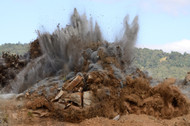Ensuring Safety and Efficiency in Commercial Blasting: Strategies to Avoid Fly Rock
Posted by Adam Kanipe on Apr 22nd 2024
Commercial blasting is a critical operation in mining, construction, and demolition industries, where precision and safety can never be compromised. One of the significant risks associated with blasting operations is the occurrence of fly rock—rock fragments that are ejected beyond the blast site, potentially causing serious safety hazards and damage. At Ideal Blasting, we prioritize safety and efficiency, and here we discuss essential strategies to minimize fly rock in commercial blasting operations.
Understanding Fly Rock
Fly rock is not just a nuisance; it is a serious safety concern. It can result from several factors such as improper blast design, inadequate burden, incorrect spacing, or the use of excessive explosives. The consequences of fly rock can range from minor injuries to severe incidents including damage to equipment and infrastructure, or even fatalities.
Best Practices to Minimize Fly Rock
1. Careful Planning and Blast Design: Proper blast design is fundamental in minimizing fly rock. This involves accurate determination of the burden (the distance from the borehole to the nearest free face), spacing, and the depth of the drill holes. Using software and modern technology can help simulate the blast beforehand to identify potential issues.
2. Use of Controlled Blasting Techniques: Implementing controlled blasting techniques such as pre-splitting, smooth blasting, and cushion blasting can significantly reduce the likelihood of fly rock. These techniques involve creating a buffer zone between the rock to be blasted and the rock to be preserved, controlling the energy distribution of the explosives.
3. Appropriate Selection of Explosives: The type and amount of explosive used have a substantial impact on fly rock. Lower velocity explosives tend to produce less fly rock. Adjusting the explosive quantity to suit the specific rock type and blast requirements is essential for reducing risks.
4. Environmental and Geological Considerations: Understanding the geological conditions is crucial. Variations in rock strength, the presence of faults, or water-filled joints can all influence the behavior of a blast. Environmental factors like wind can also affect where fly rock lands. Comprehensive pre-blast surveys help in adapting the blasting process to these conditions.
5. Training and Competence: Ensuring that all blasting personnel are trained and knowledgeable about the latest safety protocols and blasting techniques is key. Regular training updates and certifications can empower employees to handle explosives safely and effectively.
6. Monitoring and Adjustment: Use of modern monitoring equipment like drones or laser scanners to assess the pre-blast and post-blast conditions can provide valuable feedback for adjusting future blasts. This technology can track the exact location and velocity of fly rock, aiding in better planning and risk management.
Conclusion
At Ideal Blasting, our commitment to operational excellence and safety is unwavering. By adopting these strategies, commercial blasting operations can be conducted more safely, with minimized risks of fly rock. Ensuring that each blasting project is well-planned, executed by trained professionals, and monitored with the best technology guarantees not only the safety of our personnel but also the efficiency of the operation.
Stay tuned to our blog for more insights and updates on safe and efficient blasting practices, and feel free to contact us for your commercial blasting needs. Together, let's blast through challenges safely and efficiently!

